Ciné Gael Montréal Irish Film Series 1995
Our 1995 Season opened with the Canadian Premiere of Bob Quinn's The Bishop's Story, and also marked our first full fledged Evening of Irish Short Films.
This season was also notable for our collaboration with the Concordia Conservatory of Cinematographic Art, and with the Concordia Irish Students organization who arranged for Gerry Conlon to attend a screening of In the Name of the Father which was about the false imprisonment of himself and his father. Gerry Conlon spoke at our screening and also spoke to Concordia students in a separate engagement.
We closed this season with a second premiere screening, Paul Wagner's documentary, Out of Ireland.
Read more about our history on our 20th anniversary, from John Griffin at the Gazette, and this is our film schedule flyer from 1995.
with Donal McCann, Maggie Fegan, Ray McBride, Tomas O'Flaithearta, Peadar Lamb.
 This story of a priest who falls in love with his "house-keeper" is a witty and oddly relevant exploration
of what it means to fall from grace. It is also 'a beautiful celebration of non-professional Irish faces
and the rugged island of Clare, Co. Mayo' - K. Murphy, Film Society of Lincoln Centre, N.Y
This story of a priest who falls in love with his "house-keeper" is a witty and oddly relevant exploration
of what it means to fall from grace. It is also 'a beautiful celebration of non-professional Irish faces
and the rugged island of Clare, Co. Mayo' - K. Murphy, Film Society of Lincoln Centre, N.Y
Bob Quinn's latest film The Bishop's Story was somewhat of a breakthrough in that it is his first to be released in 35mm. The film however is a reworking of Quinn's 1987 film Budawanny (shot in 16mm, and which I do not discuss here), with a few new scenes shot in 35mm, some of the narrative reogranised and the release prints struck in the costlier gauge. "If Budawanny was the old Testament", he wrote in Film Ireland, "The Bishop's Story would be the New, the fulfillment of the Old."
Across these genres and forms, Quinn concens himself with the liberation of the people of Ireland, and the diversity of his work indicates his recognition of the complexity of true liberation.
In this deliberate b/w homage to the silent era, a bishop (McCann)
relates to a fellow priest (McBride) at a Roman Catholic retreat the story of how as a young man in a coastal village
in the West of Ireland he fell in love with a girl (Fegan). The flashbacks which make up the body of the film
are printed in sepia and shot in a style reminiscent of Flaherty and Sjöström. It's a nostalgic, memorable piece,
from the veteran Bob Quinn, not so much for the resigned mood of the storyteller, as for the deeply moving imagery -
a collie running up a hill; the white-clothed ankle of a girl; the dancing torches of a midnight search party;
the expressive, weather-beaten faces of the villagers. The dialogue is in Gaelic, post-synched and quiet,
as if heard from down the tunnel of memory. From TimeOut (UK)
Introduced by Padraig O Laighin, Professor and Author, Vanier College.
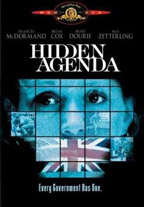 with Francis McDormand, Brian Cox, Brad Dorif, Jim Norton,
Des McAller, Mia Zetterling. Written by Jim Allen.
with Francis McDormand, Brian Cox, Brad Dorif, Jim Norton,
Des McAller, Mia Zetterling. Written by Jim Allen.
Based on a real life incident - the killing of five unarmed men and a boy in 1982.
Hidden Agenda is a riveting political thriller.
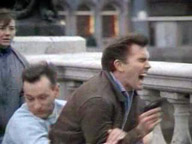 Investigator Peter Kerrigan (Cox), assisted by Ingrid Jessner (McDormand),
investigates the killing of Paul Sullivan (Dourif), an American civil rights lawyer and political activist
in Northern Ireland, whilst he was accompanied by a Provisional Irish Republican Army sympathiser.
The investigation reveals that the two men were shot without warning.
Investigator Peter Kerrigan (Cox), assisted by Ingrid Jessner (McDormand),
investigates the killing of Paul Sullivan (Dourif), an American civil rights lawyer and political activist
in Northern Ireland, whilst he was accompanied by a Provisional Irish Republican Army sympathiser.
The investigation reveals that the two men were shot without warning.
A mysterious tape recording surfaces,
made by a Captain Harris, an ex-army intelligence officer, now in hiding, of senior military leaders
and Conservative party politicians discussing how they arranged the rise to power of Margaret Thatcher.
Eventually, Harris gives a copy of the tape to Jessner, but British security forces kill Harris,
and blame his death on the IRA. Kerrigan is blackmailed into silence about the conspiracy.
Jessner still has the tape, but without Harris to authenticate it,
the recording can be dismissed as a forgery.
This political thriller is set against the backdrop of
Northern Ireland's "Troubles" and directed in the documentary fashion common to British filmmaker Ken Loach's films.
Paul Sullivan (Brad Dourif) and Ingrid Jessner (Frances McDormand) are American attorneys serving on
a human rights group working to monitor cases of prisoner mistreatment in war-torn Belfast.
When Paul learns of some information that may be injurious to the Thatcher government, he is killed,
and a top-secret tape disappears.
Assigned to the case, Inspector Kerrigan (Brian Cox) is joined by Ingrid in probing Paul's death,
which seems to be related to rumors of a high-ranking cabal within the British government working to undermine
the Irish Republican Army and liberal policies toward Irish separatists through violent and illegal means.
Ingrid meets with Harris (Maurice Roeves), a former British Secret Service agent who's now turned on his former cronies.
Together, they look for the top-secret tape. - From RottenTomatoes:
Karl Williams
with Milo O Shea, Joe Lynch, T.P. McKenna, Barbara Jefford, Martin Dempsey,
Sheila O'Sullivan, Maurice Hoeves.
"James Joyce's masterpiece made it to the screen in this brave production.
The acting is excellent..." Steven H. Sheuer - Movies on TV
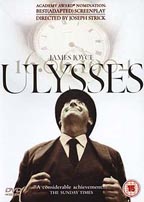
Filming The Unfilmable: Joseph Strick's Adaptation of Joyce's Ulysses by
Colm McAuliffe
In honour of Bloomsday, the day on which the fictional events of James Joyce's Ulysses take place,
Colm McAuliffe celebrates Joseph Strick's often marginalised film adaptation of this supposedly unfilmable novel.
For millions of people, June 16th is an important day. On this day, 107 years ago in 1904, two residents of Dublin,
Stephen Dedalus and Leopold Bloom, embarked on their epic converging journeys through the city,
as depicted by James Joyce in Ulysses. Over the last thirty years or so on this day, celebrants of the book
act out various scenes in cities and towns all over the world, displaying their willingness to be at one with the novel.
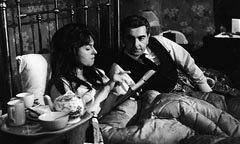 But the question is: how many people have actually read this famously difficult text? The answer is probably not very many;
this book which strove to celebrate the everyday life of the common man and woman has endured the unkind fate
of never being read by most of them.
But the question is: how many people have actually read this famously difficult text? The answer is probably not very many;
this book which strove to celebrate the everyday life of the common man and woman has endured the unkind fate
of never being read by most of them.
While the book itself may simply be too much for the everyday reader, this did not render the novel entirely unfilmable.
In fact, it took Joseph Strick, an idealistic American, to fully realise its cinematic potential. After years of frustration,
Strick managed to film the first and definitive version of Joyce on screen with his 1967 adaptation of Ulysses.
Strick died in 2010 without ever seeing requisite acclaim afforded on his achievement. Indeed, the film caused
great controversy at the time of its release. A significant number of subtitles were cut during its screening
at the Cannes Film Festival, which Strick later dismissed as "corrupt and fake, and just a mechanism for keeping the hotels open"....

The British Board of Film Censors forced 29 cuts, but eventually passed the film - it became the first in Britain
to include the word 'fuck' - after Strick re-submitted it with the 'offending' sequences replaced by a blank screen
and a shrieking soundtrack.
In Ireland, the film censor unilaterally banned the film, denouncing it as being "subversive to public morality".
It wasn't until 2000, a year after the Irish censor belatedly passed Stanley Kubrick's
A Clockwork Orange for release, that Ulysses was finally given the go-ahead for public consumption.
It is ironic that the film version suffered so many obstacles, considering the fact that Joyce,
in depicting the flaneur-like ramblings of Leopold Bloom in the novel, deployed a whole range of techniques
such as montage and rapid scene dissolves which are more commonly associated with the cinema.
Joyce was clearly a fan of the cinema as well, having opened the Volta,
one of Ireland's first dedicated cinemas in Mary Street, Dublin in 1909.
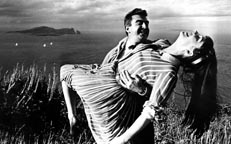 Ulysses is a novel so rooted in a sense of place that, as its author once memorably put it,
if Dublin was to "suddenly disappear from the Earth it could be reconstructed out of my book".
The decision by Strick to base his adaptation in 1960s Dublin rather than the novel's original setting of 1904
ensures that the mise-en-scene does not take away from the film text and in fact serves to highlight
the contemporaneity of Joyce. If anything, this juxtaposition of past and present affords the film a unique timelessness.
Ulysses is a novel so rooted in a sense of place that, as its author once memorably put it,
if Dublin was to "suddenly disappear from the Earth it could be reconstructed out of my book".
The decision by Strick to base his adaptation in 1960s Dublin rather than the novel's original setting of 1904
ensures that the mise-en-scene does not take away from the film text and in fact serves to highlight
the contemporaneity of Joyce. If anything, this juxtaposition of past and present affords the film a unique timelessness.
Milo O'Shea excels as Leopold Bloom, the clever and libidinous protagonist, his external dialogue wonderfully evoking
his surreal and spiralling fantasties, anchored with a vigorous undercurrent of shocking-for-its-time sexuality.
But the real star of the film is Dublin itself; the black-and-white cinematography ensures the city's aesthetic dimension
becomes a prominent character with O'Connell Street, the Ha'penny Bridge and Glasnevin Cemetery serving
as iconic visual adornments without falsifying the city's burgeoning modernity.
Up to this point, Dublin city had been primarily represented by theatre, in the early twentieth century,
via the successes of playwrights Sean O'Casey and J.M. Synge. With the advent of cinema and modernity,
adaptations of literary heavyweights rarely, if ever, used Dublin itself as a backdrop as studios preferred
the more sanitised, cardboard sets offered by Hollywood (which often were accompanied by unintended laughs
through wildly inaccurate imitations of Dublin accents and incredibly naïve captions).
Joyce's attempt to plan out the winding topography of Dublin city is perfectly realised during Leopold Bloom's
carriage ride from the south to the north of the city. Strick offers us a unique depiction of industrial Dublin
as the cavalcade travels its way through the Grand Canal and winding city streets in the 1960s.
Film critic Bosley Crowther commented upon the city's modernity during this passage, noting that
"the streets are full of automobiles. The quays along the river are crowded with modern ships."
Since Joseph Strick's attempt, film versions of Ulysses have been few and far between. Sean Walsh's 2003 effort,
Bloom, is an altogether more mundane effort, with Stephen Rea as
a far more taciturn Leopold Bloom. In contrast, Strick managed to successfully capture the humour and pathos
while adhering to the wonderful directions outlined within the novel. It is testament to his direction
that the juxtaposition of such a series of seemingly unrelated events seems effortless as the camera work
glides from one fantasy to another, straddling the boundaries between humour and horror.
Joyce's tale concerning one day in the life of a Dubliner was never meant to be for elite readers only.
Joseph Strick's film version manages to neatly sidestep all the theoretical babble and allows viewers
to enjoy a wonderfully rich story. The film sheds light on an otherwise daunting read and conveys
a humane vision of a decent life under the encroaching pressures of the modern world.
which was followed by a commentary by Gerry Conlon
with Daniel Day-Lewis, Pete Postlethwaite, Emma Thompson, Mark Sheppard, John Lynch, Anthony Brophy,
Saffron Burrows, Jamie Harris, Britta Smith, Don Baker, Corin Redgrave, Aiden Grennell, Bosco Hogan, Tom Wilkinson,
Philip Davis.
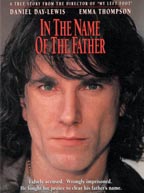
 In our flyers we said, Ciné Gael Montréal, in conjunction with the Conservatory of Cinematographic Art
is pleased to present Gerry Conlon, the real-life hero of the film who will offer a commentary after this
special screening of his story.
In our flyers we said, Ciné Gael Montréal, in conjunction with the Conservatory of Cinematographic Art
is pleased to present Gerry Conlon, the real-life hero of the film who will offer a commentary after this
special screening of his story.
Whether you have seen In the Name of the Father before or not, Cine Gael
and the Conservatory of Cinematographic Art urge you participate in this special presentation.
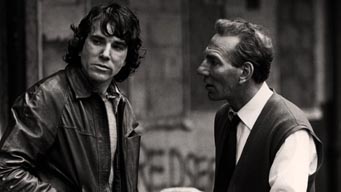 A rebellious youth in strife-torn '70s Belfast, Gerry Conlon's main interests were getting drunk and partying
- much to the dismay of his quiet frail father Giuseppe. When Gerry angered the IRA, his father sent him to England
where his antics landed him in the wrong place at the wrong time.
A rebellious youth in strife-torn '70s Belfast, Gerry Conlon's main interests were getting drunk and partying
- much to the dismay of his quiet frail father Giuseppe. When Gerry angered the IRA, his father sent him to England
where his antics landed him in the wrong place at the wrong time.
Innocent, but forced under torture to confess to a savage terrorist bombing, he was sentenced to life imprisonment
as one of the Guildford Four.
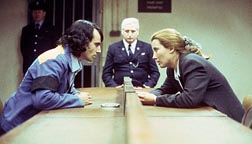 His innocent father was also arrested and jailed. Although it was widely known
that the four were innocent, they languished in jail for fifteen years until, in the end, the authorities
were forced to admit that a gross miscarriage of justice had occurred.
His innocent father was also arrested and jailed. Although it was widely known
that the four were innocent, they languished in jail for fifteen years until, in the end, the authorities
were forced to admit that a gross miscarriage of justice had occurred.
In a few areas, this film takes liberties with the truth of Gerry's story. But the images of fanaticism and brutality,
of corrupt police and of the deliberate and callous perversion of justice are frighteningly real and true.
These shorts were selected by the committee's Dublin ex-pat, Dana Hearne.
A poignant aside to that evening:
Our fifth film of the evening was Fruit 15 by Claire Lynch.
It was the only film she ever made as she was killed in a housefire in '93 while attending
the 1993 Cork Festival.
Blinder, our sixth film was awarded Best First Film at
the 1994 Cork Film Festival, an award which was established in memory of Claire Lynch.
and some historical perspective:Our first film of the evening,
Jack's Bicycle was made by John Moore. It was made in 1990,
although with the closing of the Film Board in 1987, short and feature activity in Ireland
was severely curtailed.
As a result, Moore founded ClingFilm, and turned to making commercials and was given the job of
making an ad for the launch advertisement for Dreamcast. 20th Century Fox found it so impressive
they gave him the $17 million (BTL) budget for Behind Enemy Lines
and has gone on to make blockbusters including one in the Die Hard franchise.
So, good to challenge young filmmakers with hard times?
Introduced by Kathleen O'Hara, Ciné Gael Member and Founding Member of LINC.
This is our flyer from that first shorts evening in 1995
...and we have Mick Lally, here on digital celluloid, who appeared in That's All Right,
the final short of the evening, filmed and shown by us on 35mm, using short ends from the filming of
The Dead.

Jack's Bicycle (1990) 9 mins, drama, BxW Dir: John Moore
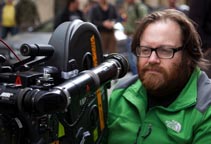 During World War II in Ireland young Jack is mocked by other kids on the street when he says that he's getting a bicycle.
He goes to a bicycle shop where he is told that a bicycle would be too expensive for him. As he nears home he sees a soldier
leave his home having given money and sausages to his mother. When he tells his mother that he saw a soldier give her money,
she hits him.
During World War II in Ireland young Jack is mocked by other kids on the street when he says that he's getting a bicycle.
He goes to a bicycle shop where he is told that a bicycle would be too expensive for him. As he nears home he sees a soldier
leave his home having given money and sausages to his mother. When he tells his mother that he saw a soldier give her money,
she hits him.
On another occasion when returning home he gag smiles when he also sees the married bicycle-shop owner leave his house.
This proves to be his way of getting a bicycle. [TCD.ie]
Best Irish Short Award at the 1991 Cork Film Festival
Detour (1994) 20 mins, drama Dir: Robert Quinn
In the 1950s, a mysterious stranger on a motorcycle puts up posters in a forest advertising a circus. Three children observe his movements,
but one of them finds an old gun and kills one of his companions. The stranger is set upon and beaten by locals,
who think he is responsible for the killing.
At the child's wake, the killer tries to tell his mother that he,
and not the stranger, was responsible for the boy's death. [TCD.ie]
Best Short Film 1994, Galway Film Fleadh
After '68 (1993) 25 mins, drama Dir: Steven Burke
In Derry, fourteen-year-old Frieda, the product of a brief liaison between a Catholic woman and a Protestant city councillor, Mr Craig,
retells their story which begins in the 1960s. Though receiving money from Frieda's father, her mother goes to see Mrs Craig,
Frieda's father's wife, who, to Frieda's discomfort, then visits her.
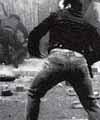 At this time the Civil Rights struggle begins, and Frieda's mother is assaulted by the RUC during marches, including on the four-day march
from Belfast to Derry which was ambushed at Burntollet Bridge by loyalists. Her father joins the newly-formed Ulster Defence Regiment,
while in 1971 the Provisional IRA kill a soldier at the end of their street. By Bloody Sunday 1972, when thirteen civilians
are killed by British soldiers, her mother can take no more and they move to a cottage across the border in Donegal.
At this time the Civil Rights struggle begins, and Frieda's mother is assaulted by the RUC during marches, including on the four-day march
from Belfast to Derry which was ambushed at Burntollet Bridge by loyalists. Her father joins the newly-formed Ulster Defence Regiment,
while in 1971 the Provisional IRA kill a soldier at the end of their street. By Bloody Sunday 1972, when thirteen civilians
are killed by British soldiers, her mother can take no more and they move to a cottage across the border in Donegal.
Her father is killed while on patrol and Frieda and her mother return to Derry for the funeral. On their way back to Donegal,
Frieda sees an ex-boyfriend with a rifle at an IRA checkpoint in the city. [TCD.ie]
Booth (1992) 9 mins, comedy Dir: Petra Conroy
A few hilarious minutes in the life of a photo-booth..
Best Short Film Award at the 1992 Galway Film Fleadh
Best Fiction Film Award at the 1993 Irish Student Film Festival
Shown in RTE's Debut slot
Fruit 15 (1991) 15 mins, drama Dir: Claire Lynch
 This film ponders the controversial issue of abortion in Ireland. A powerful story of immaculate conception as told by a mother's
as yet unborn child. The only film ever made by Lynch.
This film ponders the controversial issue of abortion in Ireland. A powerful story of immaculate conception as told by a mother's
as yet unborn child. The only film ever made by Lynch.
"Hi mom... er... I've something to tell you... eh... well, the fact is I'm to be the mother of the second messiah... er...
yes heralding Armageddon... and you're to be his granny... well no I'm not marrying the father."
1991 Fuji Scholarship Awards for Best Overall Production
...and Most Promising Direction
....and Best Editing
Shown in RTE's First View and Debut slots
Blinder (1994) 13 mins, black comedy Dir: Eve Morrison
 A light-hearted look at one man's struggle to overcome the loss of a very important part of his anatomy. A tragi-comedy about the way
people deal with fear. A young Dubliner, Danny, has his first public outing since having one of his eyes removed.
A light-hearted look at one man's struggle to overcome the loss of a very important part of his anatomy. A tragi-comedy about the way
people deal with fear. A young Dubliner, Danny, has his first public outing since having one of his eyes removed.
A young Dubliner, Danny, is out in public for the first time after an operation to remove an eye which was blinded
in a childhood accident. Self-conscious and depressed, he remembers the events which led to his present predicament,
but meets a busker with whom he shares a common eye complaint. [TCD.ie]
Best Overall Production category in the 1994 Fuji Scholarship Awards
the inaugural award of Best First Film at the 1994 Cork Film Festival
That's All Right
(1989) 5 mins, romance Dir: Billy McCannon
starring
Mick Lally, Selina Gunnery …and Elvis Presley
 In a poignant moment, a couple relive old memories on the rainy night Elvis Presley dies.
In a poignant moment, a couple relive old memories on the rainy night Elvis Presley dies.
That's All Right is a multi award winning film which debuted by opening the Cork Film festival in 1989.
It was widely exhibited at international festivals including Telluride in 1991.
It was famously shot on 35mm for the paltry sum of £300 using short ends from John Huston's The Dead.
debuted by opening the Cork Film festival in 1989
Introduced by Donato Totaro, Concordia Film Studies Department
This same pairing remains a perrenial favourite, being shown at New York's American Museum of Natural History as recently as 2010
with Coleman (Tiger) King and Maggie Dillane.
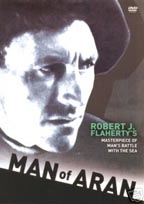 Robert Flaherty, the mellow wanderer with a camera, has made a memorable film out of the tragic and beautiful
fundamentals of human behavior in his Man of Aran, which British Gaumont presented
at the Criterion last evening. With the fervor of a poet and the skill of a magnificent cameraman he once more examines
the theme which lies close to his heart, the grim and ceaseless struggles of primitive beings to preserve their lives
against the crushing assaults of their environment. As in his Nanook of the North, he strips
his new work of dramatic artifice and plunges it to the heart of earthy and basic experience. It is bare, cruel and authentically real;
it is ardent with life, and it represents the pure cinema at its best. Expelling everything which is artistically alien
to the camera, Mr. Flaherty employs only one ally, and that is music.
Robert Flaherty, the mellow wanderer with a camera, has made a memorable film out of the tragic and beautiful
fundamentals of human behavior in his Man of Aran, which British Gaumont presented
at the Criterion last evening. With the fervor of a poet and the skill of a magnificent cameraman he once more examines
the theme which lies close to his heart, the grim and ceaseless struggles of primitive beings to preserve their lives
against the crushing assaults of their environment. As in his Nanook of the North, he strips
his new work of dramatic artifice and plunges it to the heart of earthy and basic experience. It is bare, cruel and authentically real;
it is ardent with life, and it represents the pure cinema at its best. Expelling everything which is artistically alien
to the camera, Mr. Flaherty employs only one ally, and that is music.
The Aran Islands, he tells us in his foreword, are three naked wastes of rock off the western coast of Ireland.
Empty of trees or soil or any natural gifts for the sustenance of man, they are exposed to the blind fury of the open Atlantic.
In the Winter storms, the islands are almost smothered by the boiling sea, which piles up on the bare and unfriendly cliffs
in endless and terrible cataclysms. On the Aran Islands, the negation of fruitfulness, man fights bitterly for the privilege of life.
"It is a fight," says Mr. Flaherty, after two years on the islands, "from which he will have no respite until the end
of his indomitable days."By André Sennwald
Here is a splendid theme for a man of Mr. Flaherty's imagination and he utilizes it to make a motion picture
of consummate beauty. With the raging seas for a symphonic accompaniment, he describes the daily life of the Man of Aran
and his wife and child. He shows them at their pitiful daily tasks, braving the seas in a small boat for fish,
laying seaweed and handfulls of dirt on the bare rocks for their potato planting. The endless tread-mill monotony
of their struggle for existence is written without words in the faces of the native Aranites who compose
Mr. Flaherty's cast of actors-rugged, honest faces, divorced from all the fruits of living but those of family,
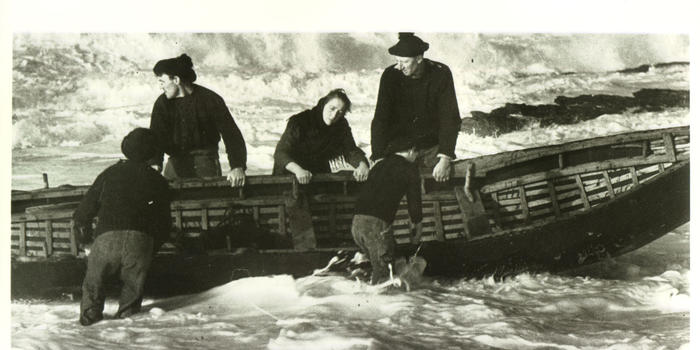 friendship and the sense of meager conquest that they get as they come to grips with life. There are some excellent scenes
of the men in a tiny curragh harpooning a whale to obtain oil for the lamps in their thatched cottages. On their journey
back from one of these trips they are caught in a wild Atlantic storm. From the cliffs the Man's wife and child
watch the small boat and pray for its safety. Miraculously the battered curragh makes the shore and the men
crawl up on the rocky ledge, leaving the boat to be broken to bits by the waves.
friendship and the sense of meager conquest that they get as they come to grips with life. There are some excellent scenes
of the men in a tiny curragh harpooning a whale to obtain oil for the lamps in their thatched cottages. On their journey
back from one of these trips they are caught in a wild Atlantic storm. From the cliffs the Man's wife and child
watch the small boat and pray for its safety. Miraculously the battered curragh makes the shore and the men
crawl up on the rocky ledge, leaving the boat to be broken to bits by the waves.
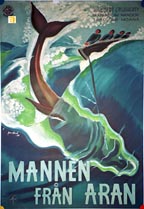 That is all the story Mr. Flaherty has to tell. Yet he gives it a remarkable vigor and impact by his constant use of contrast.
First the plodding, bowed and pathetic humans, snatching their pittance from the rocks and the water;
then their magnificent opponent, the sea, smashing eternally against the rocks in a resistless and cruel barrage of sound and fury.
That is all the story Mr. Flaherty has to tell. Yet he gives it a remarkable vigor and impact by his constant use of contrast.
First the plodding, bowed and pathetic humans, snatching their pittance from the rocks and the water;
then their magnificent opponent, the sea, smashing eternally against the rocks in a resistless and cruel barrage of sound and fury.
In the overwhelming climax the mad assault of the sea as it climbs hundreds of feet up the cliffs and sweeps
its tons of white-spumed water over the top accomplishes a sense of terror and emotional exhaustion in the spectator,
leaving him with the feeling that it is useless to continue the struggle against such odds. The musical score
is excellently blended with the screen in a fine emotional composition. Although the first impression is that
the synchronized sound and voices are an obtrusive element in the pure flow of the camera, one gradually becomes
accustomed to them. Man of Aran immediately joins the great tradition of
Grass, Tabu and Mr. Flaherty's own Nanook.
[The New York Times - October 19, 1934]
Best Foreign Film - 1934 National Board of Review
Best Foreign Film - 1934 Venice International Film Festival
Dir: by George Stoney and James B. Brown
"Pioneer documentarian and NYU film professor George C. Stoney,
along with co-director and cinematographer James B. Brown, uncover some of the misconceptions
about legendary American documentarian Robert J. Flaherty's MAN OF ARAN by returning to Flaherty's
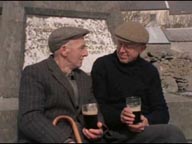 original interviews with islanders and piecing together how the filmmaker took liberal artistic license
to construct the dynamic - and embellished - narrative of the classic film."
[American Cinematheque]
original interviews with islanders and piecing together how the filmmaker took liberal artistic license
to construct the dynamic - and embellished - narrative of the classic film."
[American Cinematheque]
"Stoney's response to Robert Flaherty's classic 1934 Man of Aran revisits the Aran Islands four decades later
and interviews surviving locals about their memories of the original film and their reactions to making this one.
Examining the work of one of his intellectual forebears and its lasting effects on a community where he himself
had roots - Stoney's grandfather was the doctor on the island where Faherty made his film - the director
creates a persuasive and multi-faceted illustration of his belief that a filmmaker always leaves a mark
on the people and places he films. Includes excerpts from the original documentary."
from the American Museum of Natural History [AMNH]
with Francis Tomelty, Mark O'Shea.
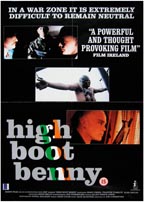 This is the story of the matron of a school - cum - old barracks in Ulster who looks for love and motherhood
with an aging defrocked priest and a wild young boy (Mark O Shea) who is more at home with animals than people.
This is the story of the matron of a school - cum - old barracks in Ulster who looks for love and motherhood
with an aging defrocked priest and a wild young boy (Mark O Shea) who is more at home with animals than people.
A police informer is found murdered in a small school pursuing a radical and independent approach to education
just south of the border between Northern Ireland and the Republic. Suspicion falls on the school's Protestant Matron
and on Manley, an ex-priest who runs the school with her. Benny, a 17 year old delinquent who has found refuge at the school,
is also implicated. In order to survive in the battle between contending 'armies', Benny has to break out of the isolation
with which he tries to protect himself. His violent rite-of-passage exposes the deceptions which surround him and force him
to take a stance. It asks the paradoxical question "On which side are you neutral?".
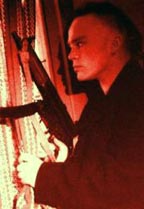 Time Out says - The occasional playfulness of
Reefer and the Model (1987) is replaced here - another response by director Comerford
to the political impasse in present-day Ireland - by a more sombre mood. This is a more straightforward allegorical tale
than its predecessor, set around a 'neutral' school run by 'The Matron' (Tomelty)
and Manley (Devlin), a maverick ex-priest, on the windswept border between North and South.
Teenage delinquent Benny, who sports a mohican and steel-shinned boots, is a metaphorical and literal outsider, who wanders
the rugged landscape that surrounds the former fort, looking after animals, and taking refuge (and physical comfort) at the school.
When the school 'caretaker' is found dead, Benny is drawn into the conflict between the police, the British Army,
the Loyalist paramilitaries, and the IRA. Into the arms of which group will he be drawn? This is a potent blend
of didactic history lessons, flourishes of elegant dark beauty, brooding psycho-drama and cold-blooded analysis. Strong performances.
Time Out says - The occasional playfulness of
Reefer and the Model (1987) is replaced here - another response by director Comerford
to the political impasse in present-day Ireland - by a more sombre mood. This is a more straightforward allegorical tale
than its predecessor, set around a 'neutral' school run by 'The Matron' (Tomelty)
and Manley (Devlin), a maverick ex-priest, on the windswept border between North and South.
Teenage delinquent Benny, who sports a mohican and steel-shinned boots, is a metaphorical and literal outsider, who wanders
the rugged landscape that surrounds the former fort, looking after animals, and taking refuge (and physical comfort) at the school.
When the school 'caretaker' is found dead, Benny is drawn into the conflict between the police, the British Army,
the Loyalist paramilitaries, and the IRA. Into the arms of which group will he be drawn? This is a potent blend
of didactic history lessons, flourishes of elegant dark beauty, brooding psycho-drama and cold-blooded analysis. Strong performances.
"It is a division about identity and democracy, about private emotions and public survival.
High Boot Benny is an allegory on a conflict which has produced more deception than truth."
Joe Comerford
Winner of the Prize of Discovery, Aubagne Film Festival, 1994
and the Best Young European Actor Prize for Marc O'Shea,
Beziers Film Festival, 1994.
Introduced by Montreal Gazette Film Critic, John Griffin
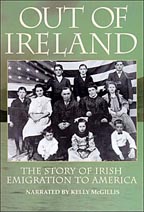 The history of Irish immigration to the United States beginning with the exodus from the famine-swept villages of 19th century
Ireland to the industrialized cities of 20th century America.
The history of Irish immigration to the United States beginning with the exodus from the famine-swept villages of 19th century
Ireland to the industrialized cities of 20th century America.
 This fascinating 1995 documentary covers two hundred years of Irish-American immigrant history. The chronicle is interwoven
with a plethora of stills, drawings, on-location re-creations, historian interviews and personal stories of some of the more famous
Emerald Isle emigrants, such as Aidan Quinn and Liam Neeson. Actress Kelly McGillis narrates this celebrated PBS piece,
which also follows the lives of eight immigrants through their touching personal letters home to family members suffering through
the mid-19th century famine.
This fascinating 1995 documentary covers two hundred years of Irish-American immigrant history. The chronicle is interwoven
with a plethora of stills, drawings, on-location re-creations, historian interviews and personal stories of some of the more famous
Emerald Isle emigrants, such as Aidan Quinn and Liam Neeson. Actress Kelly McGillis narrates this celebrated PBS piece,
which also follows the lives of eight immigrants through their touching personal letters home to family members suffering through
the mid-19th century famine.
In Ireland, the story is of a people yearning for change even as they clung desperately to ancient traditions. In America,
the story is of policemen and maids, priests and politicians, rogues, wanderers, and victims of discrimination, bemoaning their
forced departure from the Old World even as they reaped the benefits of the New World.
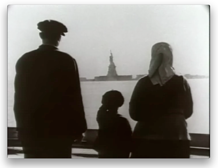 The mid-19th century famine in Ireland set the stage for one of the first great waves of European immigrants to America.
They tested and profoundly changed America's notion of itself. As Walt Whitman would say, America had become a "nation of nations."
Out of Ireland, therefore, is about all Americans and the profound historical and psychological consequences,
which are out heritage as a nation of Immigrants.
The mid-19th century famine in Ireland set the stage for one of the first great waves of European immigrants to America.
They tested and profoundly changed America's notion of itself. As Walt Whitman would say, America had become a "nation of nations."
Out of Ireland, therefore, is about all Americans and the profound historical and psychological consequences,
which are out heritage as a nation of Immigrants.
Musician Mick Moloney created the film soundtrack of traditional Irish music and is interviewed and sings in the film.
The soundtrack includes performances by Eileen Ivers, John Doyle, Seamus Egan, Tommy Hayes, Jerry O'Sullivan, John Williams,
Jimmy Keane and Eugene O'Donnell.
Voice over by Liam Neeson, Gabriel Byrne, Aidan Quinn, Brenda Fricker, Michael Thornton and Pauline Cadell





 click here!
click here!